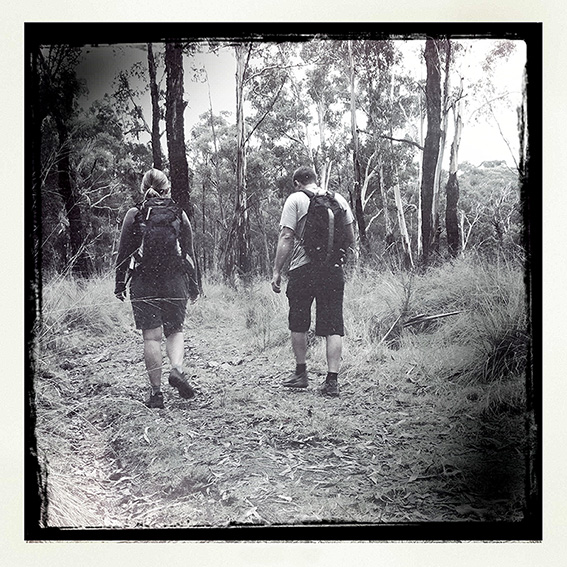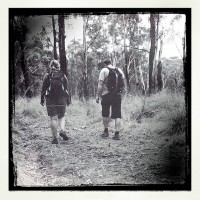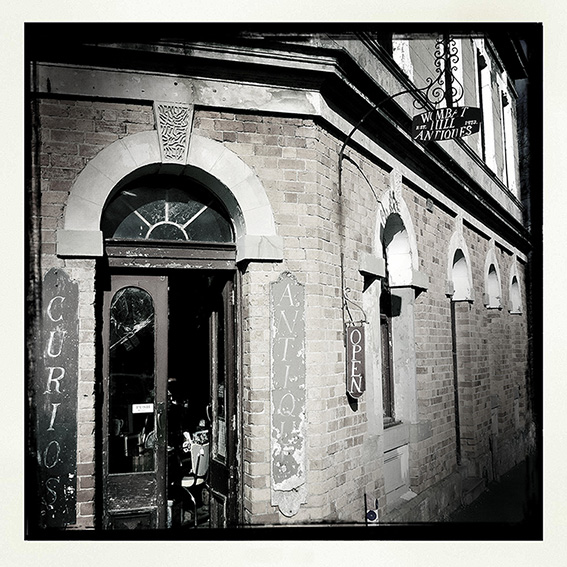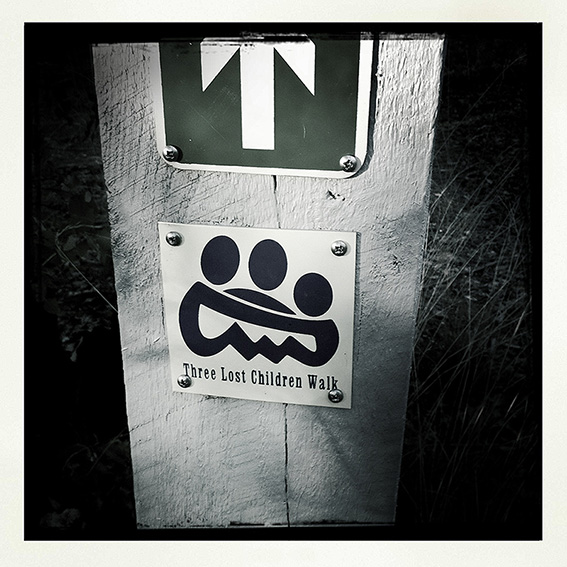
One of the walks we are writing up for our forthcoming walking guide to the Goldfields is the route followed by three children that went missing from Daylesford on the on the last day of June in 1867. William Graham (6), his brother Thomas (4) and Alfred Burman (5) decided to look for wild goats in the forest beyond Wombat Creek. Despite a massive search of the area their bodies were not found until three months later. The two younger boys were huddled together inside the hollow of a large tree and the remains of the older boy were just outside. For the people of Daylesford it was a heart rending-tragedy, one that still sears into the consciousness of the town.
The walk leaves from Table Hill just west of the town centre and finishes at Wombat Creek just underneath Wheelers Hill where the children were later found. The walk is 15.5km long and is marked with distinctive Three Lost Children Walk marker posts. The distance travelled by the children will never be accurately measured but, considering their age and circumstance, it is amazing they walked as far as they did.
Here is a newspaper report from Perth Gazette and W.A. Times, dated August 16th, 1867. The children had still not been found and their mysterious disappearance was still being reported in the national newspapers.
Late on Sunday night, the 30th of last June, the Daylesford police were told a sad story of missing children. At 10 o’clock that morning three boys, William Graham, aged 7; Thomas Graham, aged 4; and Arthur (sic) Burman, aged 5 years, the sons of respectable persons, started from their homes, in Connell’s Gully, to search for wild goats. They did not come back to dinner, and the fathers, somewhat alarmed, started with some neighbours to look for them. By some means or other it was ascertained that they had gone towards the junction of two creeks, but all traces were lost on the ranges between Sailor’s Creek and Blanket-flat. Night set in, and the anxious fathers spoke to the police, three of whom turned out at once and joined the parents and Blanket-flat police in a search which lasted till one o’clock in the morning. The night was cold and dark, and as no good could be done by looking, further operations were suspended till the morning. Then further inquiries elicited that a storekeeper named Mutch had seen the children four miles on the Ballan-road, and had directed them to follow the telegraph wires back to Daylesford. They must have been afterwards led astray by the beaten track to Specimen-hill, on which, about dusk, they met a boy named Quinn, who told them that they were going from Connell’s Gully instead of to it. The eldest boy did not seem at all alarmed; but since Quinn left them they have been lost. This information was the result of Monday’s search, in which they were joined by the men on the Corinella mine, the Telegraph saw-mills, and Clarke’s mills, and nearly all the splitters in the terrible forest. The weather was boisterously wet and cold, but though it obliterated tracks it did not deter the zealous searchers, who at last found impressions of two different-sized children’s shoes, two miles from Specimen-hill, and in the direction of the source of the Werribee River. This is all Bullarook forest, and a nearly impenetrable region, the scrub growing high and abundantly, so that a man might securely hide from his pursuers a very few feet from them. Even the searchers themselves got bewildered, and when night set in the task was abandoned in despair. The party returned to Daylesford on Tuesday evening; but so violent was the ebullition of public feeling at this want of success, that a public meeting at Bleackley’s Hotel was called that very night. The town crier went round, the fire-bell rung, and at eight p.m. the large room of the inn was filled to suffocation. The mayor presided, and with one voice it was agreed that business should be utterly suspended next day, that the search might be prosecuted by the inhabitants and the police, who had obtained the service of black trackers. The rendezvous was fixed at the specimen-hill works, the manager of which kept the whistle, which could be heard two miles, sounding till nightfall. The fire-bell was also rung at given hours, and all day long the work continued under the guidance of experienced bushmen, who carried bread and wine for the revival of the lost ones if found. Altogether, 600 or 700 persons joined in the search. Though all was in vain, the labor of love was not suspended. Next day the shops were still kept shut, 500 persons went out, and in the evening £70 was collected and offered as a reward for the recovery of the lost children. The reward was subsequently increased to £200; and the Government offered a reward of £100 more, but this was for the encouragement of bushmen and others, not the people of Daylesford and neighbourhood, who continued their exertions all through the week with such utter selfishness that it was only to remove a great public inconvenience that shops were partially opened on Friday. All was still in vain, however, and a month has elapsed without furnishing the faintest clue to the fate of these poor children. The two fathers, Graham and Burnan, have written to a local paper to express their sincere and heart-felt thanks to the inhabitants of Daylesford, and their satisfaction that all that human aid could do has been done. The children cannot possibly have survived, although they were accustomed to travel about the ranges, were familiar with their father’s stores of camping in the bush when he was a trader among the Caffres, and the eldest one had often talked of what he would do if benighted in the bush. The pecuniary sacrifice made by the people of Daylesford, beside their offer of reward, cannot be less than £2,500. Melancholy as this story is, it has a bright side in its exhibition of an unselfish public spirit, which we are convinced is not confined to Daylesford, and of which we as Victorians have good reason to be proud.



